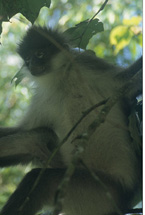Get
To Know
|
 The White-Thighed Sirili is arboreal and lives amongst the sub-montane
forests and swamp areas of the Thai-Malay Peninsula, the Riau Archipelago
and Sumatra. Their diet consists of seeds, fruits and leaf shoots.
They have also been seen consuming flowers. They are characterized
by the white patches located on the outside of their legs--which
is what gives them their name-and they range from 41-69 cm tall
and weighting 5-6.7 kg. They have a brown-grey fur coat on their
backs, with white fur covering their bellies and dark fur on their
head. Their tails--typically covered in dark fur--can extend roughly
58-85 cm. Compared to adults, infants are born with very light fur
with crosses of dark fur along their arms and back. They live in
small unimale-multifemale groups. After mating, females give birth
to single infants to which the group of females care for. Due to
their arboreal lifestyle, reliance on detection of predators is
vital. Male group members are able to call or display a distraction
for predators to protect group members. Their current status is
near threatened. They are mainly affected by agriculture, harvesting
of wood, as well as hunting. In regards to logging, the production
of access roads into forests has increased the deforestation rate
by 8% which reduces their habitat and creates a huge reduction of
seeds, leaves and fruit available. To compensate for their lost
food supply, they have been found to raid crops on the plantations--for
instance, leaves of the oil palm--which increases reports of capturing
and killing the primates. As well, they are sometimes kept as pets
or used in the entertainment industry and that has led to their
decimation in some regions of their domain.
The White-Thighed Sirili is arboreal and lives amongst the sub-montane
forests and swamp areas of the Thai-Malay Peninsula, the Riau Archipelago
and Sumatra. Their diet consists of seeds, fruits and leaf shoots.
They have also been seen consuming flowers. They are characterized
by the white patches located on the outside of their legs--which
is what gives them their name-and they range from 41-69 cm tall
and weighting 5-6.7 kg. They have a brown-grey fur coat on their
backs, with white fur covering their bellies and dark fur on their
head. Their tails--typically covered in dark fur--can extend roughly
58-85 cm. Compared to adults, infants are born with very light fur
with crosses of dark fur along their arms and back. They live in
small unimale-multifemale groups. After mating, females give birth
to single infants to which the group of females care for. Due to
their arboreal lifestyle, reliance on detection of predators is
vital. Male group members are able to call or display a distraction
for predators to protect group members. Their current status is
near threatened. They are mainly affected by agriculture, harvesting
of wood, as well as hunting. In regards to logging, the production
of access roads into forests has increased the deforestation rate
by 8% which reduces their habitat and creates a huge reduction of
seeds, leaves and fruit available. To compensate for their lost
food supply, they have been found to raid crops on the plantations--for
instance, leaves of the oil palm--which increases reports of capturing
and killing the primates. As well, they are sometimes kept as pets
or used in the entertainment industry and that has led to their
decimation in some regions of their domain.
|
|
|
|
Monday Afternoon, Norfolk Prison
by
James Hannon
In the visiting room four children gaze
hungrily at the face of their father.
He twirls the red curls of the baby
whose arms are wrapped around his neck.
He holds the hand of the pre-teen girl
who leans on his shoulder for an hour.
His little boy is draped on his back
and a ballerina dances around them all.
When they leave their mother is smiling
and the children walk in rhythm,
arms around each other.
So touching a scene that I almost forget--
what about the victims?
James Hannon is a clinical sociologist and political
activist in Massachusetts. His poems have appeared in Blue Lake Review,
Cold Mountain Review, The Fear of Monkeys, Muddy River Poetry Review,
Soundings East, and other journals, and in Gathered: Contemporary
Quaker Poets (Sundress, 2013). His collection, The Year I Learned
the Backstroke, was published by Aldrich Press. "Sarajevo Monday"
was Previously published in Courtship of Winds, Winter 2016.
|
 The
White-Thighed Sirili -
Issue Thirty-Six
The
White-Thighed Sirili -
Issue Thirty-Six